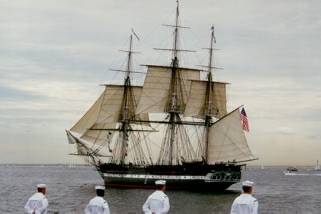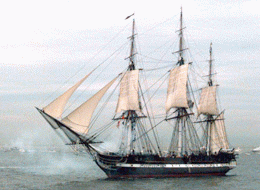USS Constitution was one of six frigates authorized for construction by an act of Congress in 1794. Joshua Humphreys designed them to be the Navyís capital ships. Larger and more heavily armed than the standard run of frigate, Constitution and her sisters were formidable opponents even for some ships of the line.
Built in Boston of resilient live oak, Constitutionís planks were up to seven inches thick. Paul Revere forged the copper spikes and bolts that held the planks in place and the copper sheathing that protected the hull. Thus armed, she first put to sea in July 1798 and
saw her first service patrolling the southeast coast of the United States during the Quasi-War with France.
In 1803 she was designated flagship for the Mediterranean squadron under Captain Edward Preble and went to serve against the Barbary States of North Africa, which were demanding tribute from the United States in exchange for allowing American merchant
vessels access to Mediterranean ports.
Preble began an aggressive campaign against Tripoli, blockading ports and bombarding fortifications. Finally Tripoli, Tunisia and Algeria agreed to a peace treaty.
Constitution patrolled the North African coast for two years after the war ended, to enforce the terms of the treaty.
She returned to Boston in 1807 for two years of refitting. The ship was recommissioned as flagship of the North Atlantic Squadron in 1809 under Commodore John Rodgers.
By early 1812, relations with Great Britain had deteriorated and the Navy began preparing for war, which was declared June 20. Captain Isaac Hull, who had been appointed Constitutionís commanding officer in 1810, put to sea July 12, without orders,
to prevent being blockaded in port. His intention was to join the five ships of Rodgersí squadron.
Constitution sighted five ships off Egg Harbor, N.J., July 17. By the following morning the lookouts had determined they were a British squadron that had sighted Constitution and were giving chase. Finding themselves becalmed, Hull and his seasoned crew put boats
over the side to tow their ship out of range. By using kedge anchors to draw the ship forward, and wetting the sails down to take advantage of every breath of wind, Hull slowly made headway against the pursuing British. After two days and nights of toil in the
relentless July heat, Constitution finally eluded her pursuers.
But one month later, she met with one of them again ó the frigate Guerriere. The British ship fired the first shot of the legendary battle; 20 minutes later, Guerriere was a dismasted hulk, so badly damaged that she was not worth towing to port. Hull had used his heavier broadsides and his shipís superior sailing ability, while the British, to their astonishment, saw that their shot seemed to rebound harmlessly off Constitutionís hull ó giving her the
nickname 'Old Ironsides'.
Under the command of William Bainbridge, 'Old Ironsides', met Java, another British frigate, in December. Their three-hour engagement left Java unfit for repair, so she was
burned. Constitutionís victories gave the American people a tremendous boost to morale, and raised the United States to the rank of a world-class naval power.
Despite having to spend many months in port, either under repair or because of blockades, Constitution managed eight more captures, including a British frigate and sloop sailing in company which she fought simultaneously, before peace was declared in 1815.
After six years of extensive repairs, she returned to duty as flagship of the Mediterranean Squadron. She sailed back to Boston in 1828.
An examination in 1830 found her unfit for sea, but the American public expressed great indignation at the recommendation that she be scrapped, especially after publication of Oliver Wendell Holmesí poem 'Old Ironsides'. Congress passed an appropriation for
reconstruction and in 1835 she was placed back in commission. She served as flagship in the Mediterranean and the South Pacific and made a 30-month voyage around the world
beginning in March 1844.
In the 1850s she patrolled the African coast in search of slavers, and during the Civil War served as a training ship for midshipmen.
After another period of rebuilding in 1871, she transported goods for the Paris Exposition of 1877 and served once more as a training ship. Decommissioned in 1882, she was used as a receiving ship at Portsmouth, N.H. She returned to Boston to celebrate her centennial in 1897.
In 1905, public sentiment saved her once more from scrapping; in 1925 she was restored, through the donations of school children and patriotic groups. Recommissioned in 1931, she set out under tow for a tour of 90 port cities along the Atlantic, Gulf and Pacific coasts of the United States.
More than 4,600,000 people visited her during the three-year journey. Having secured her position as an American icon, she returned to her home port of Boston. In 1941, she was placed in permanent commission, and an act of Congress in 1954 made the Secretary of the Navy responsible for her upkeep.
Now the oldest U.S. warship still in commission, Constitution remains a powerful reminder of the nationís earliest steps into dominance of the sea.

Builders: Col. George Claghorn, Edmond Harrt's Shipyard, Boston, Mass.
Unit Cost: $302,718 (1797 dollars)
Power Plant: 42,710 sq. ft. of sail on three masts
Length: 204 feet (62.16 meters) (billet head to taffrail); 175 feet at waterline (53.32 meters)
Beam: 43.5 feet (13.25 meters)
Mast height: foremast, 198 feet (60.33 meters); mainmast, 220 feet (67.03 meters);
mizzenmast, 172.5 feet (52.56 meters)
Displacement: 2,200 tonsSpeed: 13+ knots (approx. 14.95 miles per hour, 24 km. per hour)
Crew: 450 including 55 Marines and 30 boys (1797)
Armament: 32 24-pounder long guns; 20 32-pounder carronades; and, two 24-pounder bow chasers.
Boats: one 36-ft. long boat; two 30-ft. cutters, two 28-ft. whaleboats; one 28-ft. gig; one
22-ft. jolly boat; and one 14-ft. punt.
Anchors: two main bowers (5300 lbs.); one sheet anchor (5400 lbs.); one stream anchor (1100 lbs.); and two kedge anchors (400 to 700 lbs).
Date Deployed: October 21, 1797
Lorraine Ramsdell
Naval Reserve Office of Information

Old Ironsides
By Oliver Wendell Holmes
September 16, 1830
Ay, tear her tattered ensign down!
Long has it waved on high,
And many an eye has danced to see
That banner in the sky;
Beneath it rung the battle shout,
And burst the cannon's roar;--
The meteor of the ocean air
Shall sweep the clouds no more.
Her deck, once red with heroes' blood,
Where knelt the vanquished foe,
When winds were hurrying o'er the flood,
And waves were white below,
No more shall feel the victor's tread,
Or know the conquered knee;--
The harpies of the shore shall pluck
The eagle of the sea!
Oh, better that her shattered bulk
Should sink beneath the wave;
Her thunders shook the mighty deep,
And there should be her grave;
Nail to the mast her holy flag,
Set every threadbare sail,
And give her to the god of storms,
The lightning and the gale!
Back To Famous Places & Events
Free Pet Newsletter
Search Our Site
Pet Care Tips Directory
Really Neat Gifts for All Pet Lovers
Stuffed Plush Animals
Canine Care Tips
Feline Care Tips
Horse Care Tips
Site Map
Copyright ©
Choose To Prosper